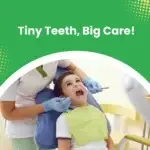During your child’s next 6 month check-up, ask your pediatric dentist about dental sealants and how they can prevent cavities. Children frequently find it difficult to clean the minuscule grooves in their teeth, especially the molars at the rear of their mouths. Sealants are useful in this situation.
How Do Sealants Work?
Sealants are made of plastic resin that has been hardened and used to shield teeth from microorganisms. The sealant is sealed into the grooves of the chewing surface when it is applied to a tooth. In order to avoid tooth decay, there are no longer any areas on the chewing portion of the tooth that a toothbrush cannot clean.
When explaining dental sealants to children, we at Little Kids Dentistry frequently use the analogy of a raincoat or shield to illustrate how they work to prevent food acids and germs from settling into the teeth.
What To Expect When Getting Sealants
Quick and painless, sealants! The application of a sealant often requires just one visit, and all regular activities can continue right away after the appointment. We’ll place cotton in your mouth to ensure that your teeth are comfortable and kept dry before applying the sealant. In order to get ready to apply the sealant, we clean your tooth next. Your child’s pediatric dentist will apply the sealant, harden it with a blue light, and then polish the tooth to help prevent cavities and bacteria. Since sealants are normally clear or white, they cannot be seen when you smile or speak.
Children should continue to brush and floss every day even if they have sealants. Teeth are not entirely shielded from cavities by sealants. Your pediatric dentist will check to see if your sealants need to be repaired or reapplied at your subsequent examination. Although sealants should last for several years, they may eventually need to be changed if they become loose or worn out.
Do I Need to Seal My Child’s Teeth?
Sealants might be a possibility to take into account if your child struggles with brushing properly. Since children and teenagers’ teeth are still developing and may show early indicators of dental decay, these age groups are where sealants are most frequently utilized. The best way to find out for sure is to discuss sealants with your child’s pediatric dentist when you go in for your next appointment.










